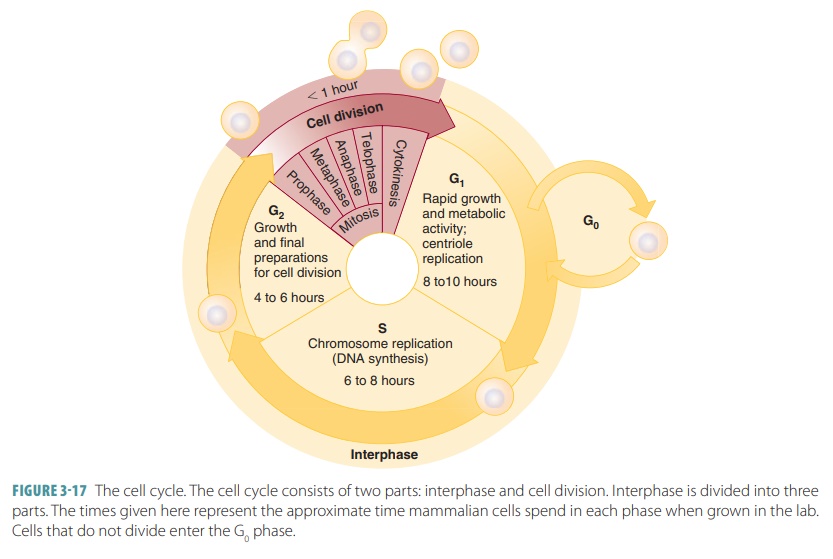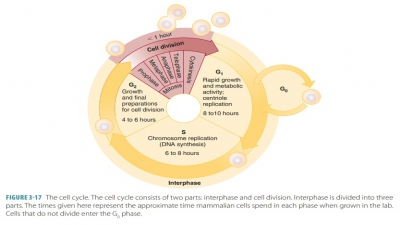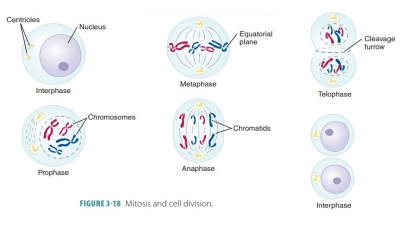Cell Cycle: Interphase
| Home | | Anatomy and Physiology | | Anatomy and Physiology Health Education (APHE) |Chapter: Anatomy and Physiology for Health Professionals: Levels of Organization : Cells
The cell obtains nutrients to grow andduplicate. This is actually the period from cell for mation to cell division. This step may be betterunderstood as being a metabolic or growth phase.

Cell Cycle
The life cycle of each cell is
regulated via stimulation from hormones or growth factors. Disruption of the
cycle can affect the health of the body. Most human cells divide from 40 to 60
times before they die. The life cycle of a cell includes the following steps:
■■ Interphase: The cell obtains
nutrients to grow andduplicate. This is actually the period from cell for
mation to cell division. This step may be betterunderstood as being a metabolic
or growth phase.
■■ Cell division (mitosis): The
nucleus divides.
■■ Cytoplasmic division
(cytokinesis): The cytoplasmdivides.
■■ Differentiation: The cell becomes specialized.
Interphase
A cell must grow and duplicate
most of its contents before it can actively divide (FIGURE
3-17). Interphase describes this period of the cell preparing to divide.
During interphase, the cell manufactures new living material, duplicating
membranes, lysosomes, mito-chondria, and ribosomes. It also replicates its own
genetic material. Interphase is divided into an initial growth phase (G1
phase), a synthesis phase (S phase), and a final growth phase (G2
phase). Chromatin is produced only during the S phase.

In the G1 phase, the
cell is metabolically active, with rapid protein synthesis and growth. This
phase may vary widely in its length. Cells that divide rap-idly may do so in
minutes to hours, but cells that divide slowly may last for days to years. Any
cell that permanently stops dividing is described as being in the G0
phase. Nearly no cell division activities occur during the G1 phase.
As this phase ends, the centrioles begin replication, preparing for cell
division.
In the S phase, DNA is
replicated, so identical copies of genetic material are received by the two
future cells. Chromatin is assembled by the making of new histones (basic alkaline proteins). There can be no correct mitotic
phase without the S phase also being correctly accomplished. The process of
DNA replication involves enzymes attaching to origins or replication. The DNA
strands separate, with replica-tion
bubbles forming. A Y-shaped
replication fork onthe end of each bubble is where helical parental DNA
strands are unwound. These strands help to make com-plementary DNA strands.
However, new nucleotides can only be added to preexisting strands and cannot be
manufactured newly. Therefore, a short RNA
primer is formed by a primase enzyme.
The enzyme DNA poly-merasealigns
complementary nucleotides along thestrand and links them together using
covalent bonds only in one direction. The leading
strand is synthe-sized continuously once it has been primed, according to
the movement of the replication fork. Another lag-ging strand is made in segments in the opposite direc-tion. It
requires that a primer replicates each segment. Short segments of DNA are
spliced together by ligaseenzymes.
The primers are then replaced by DNA poly-merases with DNA nucleotides.
In the very brief G2
phase, cell division-influencing enzymes and other proteins are synthesized
and moved to their required sites. Centriole replication finishes and the cell
is now ready to divide. The cell has continued to grow through this phase as
well as the S phase and also has been functioning normally.
Ultimately, two DNA molecules are
formed from the original template strands (DNA helix), which are identical to
their parents. Each new mol-ecule has one old and one new nucleotide strand, a
process known as semiconservative
replication. Histones then work with the DNA to make two new chromatin
strands that are joined by a centromere. Via a protein complex called cohesin, they remain together until the
anaphase stage of mitotic cell division. Distribution then occurs to the
daughter cells, with identical genetic information. If any DNAdamage has
occurred during the entire process, the cell cycle often stops until the DNA is
repaired. How-ever, the cell cycle may also cause a cellular change to occur or
even develop into cancer.
Related Topics


